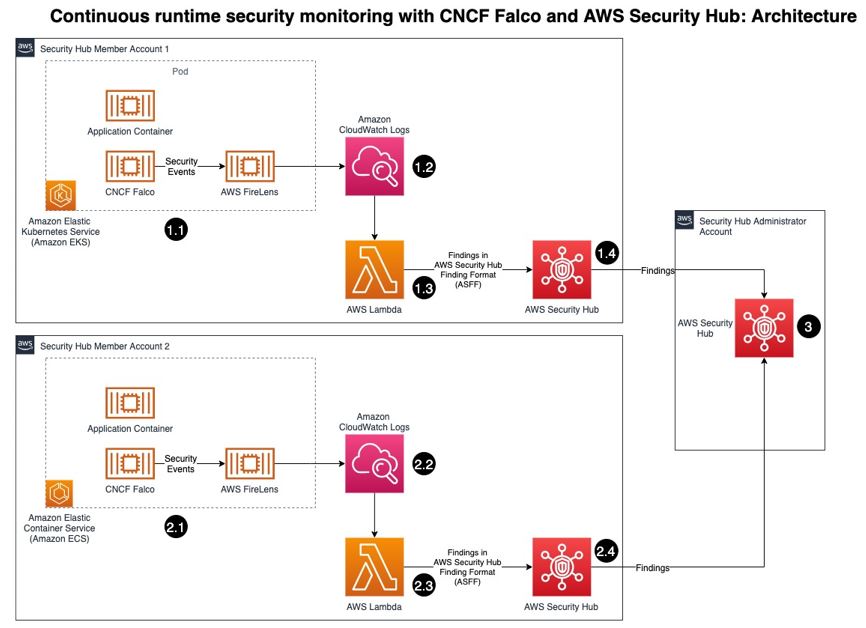AWS Security Blog
Category: Advanced (300)
Continuous runtime security monitoring with AWS Security Hub and Falco
Customers want a single and comprehensive view of the security posture of their workloads. Runtime security event monitoring is important to building secure, operationally excellent, and reliable workloads, especially in environments that run containers and container orchestration platforms. In this blog post, we show you how to use services such as AWS Security Hub and […]
How to set up Amazon Cognito for federated authentication using Azure AD
September 8, 2023: It’s important to know that if you activate user sign-up in your user pool, anyone on the internet can sign up for an account and sign in to your apps. Don’t enable self-registration in your user pool unless you want to open your app to allow users to sign up. In this […]
Managing temporary elevated access to your AWS environment
September 27, 2023: We updated this post to include a list of newer temporary elevated access solutions that integrate with AWS IAM Identity Center. September 9, 2022: This blog post has been updated to reflect the new name of AWS Single Sign-On (SSO) – AWS IAM Identity Center. Read more about the name change here. […]
Managing permissions with grants in AWS Key Management Service
August 9, 2022: This post has been updated to correct the references on RDS documentation. February 22, 2022: This post has been updated to clarify details of the example KMS grants provided in this blog. AWS Key Management Service (AWS KMS) helps customers to use encryption to secure their data. When creating a new encrypted […]
Forensic investigation environment strategies in the AWS Cloud
When a deviation from your secure baseline occurs, it’s crucial to respond and resolve the issue quickly and follow up with a forensic investigation and root cause analysis. Having a preconfigured infrastructure and a practiced plan for using it when there’s a deviation from your baseline will help you to extract and analyze the information […]
Migrate and secure your Windows PKI to AWS with AWS CloudHSM
Feb 17, 2025: This blog post references AWS CloudHSM Client SDK 3, which is no longer the recommended version. AWS recommends that you use the latest version, AWS CloudHSM Client SDK 5, which provides updated functionality and commands. We are currently working on an updated blog post for CloudHSM Client SDK 5. See the AWS […]
Correlate security findings with AWS Security Hub and Amazon EventBridge
March 31, 2022: We updated the CloudFormation template, accessed via the Launch Stack link, in this blog post. In this blog post, we’ll walk you through deploying a solution to correlate specific AWS Security Hub findings from multiple AWS services that are related to a single AWS resource, which indicates an increased possibility that a […]
How to set up a two-way integration between AWS Security Hub and Jira Service Management
If you use both AWS Security Hub and Jira Service Management, you can use the new AWS Service Management Connector for Jira Service Management to create an automated, bidirectional integration between these two products that keeps your Security Hub findings and Jira issues in sync. In this blog post, I’ll show you how to set up this integration. […]
Validate IAM policies in CloudFormation templates using IAM Access Analyzer
In this blog post, I introduce IAM Policy Validator for AWS CloudFormation (cfn-policy-validator), an open source tool that extracts AWS Identity and Access Management (IAM) policies from an AWS CloudFormation template, and allows you to run existing IAM Access Analyzer policy validation APIs against the template. I also show you how to run the tool […]
Securely extend and access on-premises Active Directory domain controllers in AWS
August 10, 2022: This blog post has been updated to reflect the new name of AWS Single Sign-On (SSO) – AWS IAM Identity Center. Read more about the name change here. If you have an on-premises Windows Server Active Directory infrastructure, it’s important to plan carefully how to extend it into Amazon Web Services (AWS) […]









